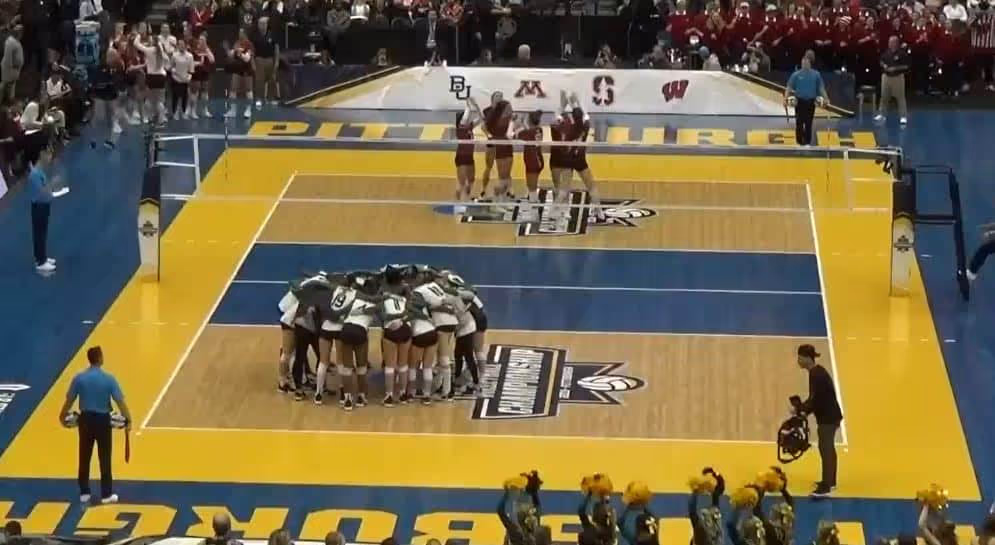Is a One-Handed Toss or Two-Handed Toss Better for Volleyball Float Servers?
At our volleyball coaching clinics, our clinicians break into small groups to teach serving keys and principles to our attendees. We then demo the different types of serves, starting with a standing float serve and ending with a top spin jump serve. The question here is, what is the most effective serve in volleyball?
The most popular serve in girl's and women's volleyball is a jump float serve. There are two types of effective jump float serves. First, a one-handed toss jump float serve.
https://goldmedalsquared.com/wp-content/uploads/2022/03/gms-blog-one-handed-toss-serve.mp4
After we demo the one-handed toss, we then demonstrate the second type of jump float serve, a two-handed toss jump float serve.
https://goldmedalsquared.com/wp-content/uploads/2022/03/gms-blog-two-handed-toss-serve.mp4
As we teach these types of serves, our clinicians are commonly asked, "Which type is most effective?"
To help us determine what is the most effective serve in volleyball, we dove into the stats of over a hundred women's college volleyball servers from two different pre-determined groups of players. First, we looked at every server from the West Coast Conference that has at least 50 serving attempts throughout the 2021 season. Second, we looked at the top 50 servers in the country, sorted by total aces. After compiling the raw serving stats for each of these servers, we sorted each server into one of four categories:
- Standing server
- One-handed toss jump float server
- Two-handed toss jump float server
- Topspin jump server

The first group of servers from the West Coast Conference has over 21,000 serves in the sample size.
Looking at the chart above shows just how popular the one-handed toss is, with over 80 percent of the conference's servers using this type of toss.
Statistically, the two-handed tossers outperformed their one-handed tosser counterparts in every single serving metric except for error percentage. When looking at server rating, ace percentage, ace-to-error ratio, and opponent's good pass percentage, the two-handed tosses were better, even if just barely.
Our next group of servers gives us another 21,000+ serves to look at.
Interestingly, 24 percent of the nation's toughest servers used a two-handed toss, a notable observation when compared to the only 12 percent of servers from the WCC.
Again, the two-handed tossers were better than one-handed tossers in all of the most important serving stats.
What's the takeaway?
By Rob Browning, Saint Mary's College, 4-time Olympic Assistant Coach
"Both the 1-hand and the 2-hand toss jump-float serves can be effective. Data certainly support this claim. We’ve all gone predominantly 1-hand because we like the idea and feel of having our hitting arm free to hit the ball — unencumbered by using it to toss.
When I was with the USA men’s team as an assistant I would serve a lot of jump floaters at the players for passing reps. I got quite good at it with a 2-hand toss and was an advocate of that technique. Later, when I was teaching coaches the different techniques, I practiced the 1-hand toss and liked it so much that I abandoned the 2-hand toss for myself whenever I would serve to passers. Now I have developed that motor program so much that the 2-hand toss feels awkward.
However! My casual observations of the two techniques haunt me. My assistant coach and former player Mandy Bible and I have a running joke about the history of our best, most effective servers at Saint Mary’s — almost all of whom used a 2-hand toss: Mandy, Missy White, Dalas Dodd, Crash Parker, Elena Baka. (Mandy’s argument goes beyond the technique and into her personal bias that all but one on that list are setters!) They all used 2 hands to toss and they all had devastating jump floaters.
Furthermore, we have a few USA national team players to bolster the anecdotal evidence in favor of the 2-hand toss jump float. Some of the best served with a 2-hand toss: Cassidy Lichtman and Kim Hill on the women’s side, and David Lee on the men’s side. There are others who could be added to that list.
The bottom line is, we coaches should encourage our players to experiment with both, especially when they are young."
Are the above stats enough to definitively say, "two-handed tosses are better than one-handed tosses"? Maybe, maybe not. You can choose to analyze these stats, with a statistically significant sample size, how you wish.
However, we can certainly say with a high level of confidence, that a two-handed toss is certainly not worse, which has become a more common belief among coaches recently.
We should encourage our athletes to try both options before ultimately committing to one type of serve or the other. Just a few weeks ago I helped a tenth grader shift from a one-handed toss to a two-handed toss. She admitted to me that she had never tried a two-handed toss before, but after just a few minutes of trying, she decided that she preferred a two-handed toss.
If you coach beginners, be sure to give your young players a significant amount of serving reps with both types of tosses and don't discourage a two-handed toss as a general rule. If you're working with an experienced player that may be struggling from the service line, consider a change on the way she tosses the ball. She may be more comfortable and effective with a two-handed toss (or vice versa). Finally, if you want your team to get more aces and knock your opponents out of system more often, become a better teacher and coach of the two-handed jump float serve.






